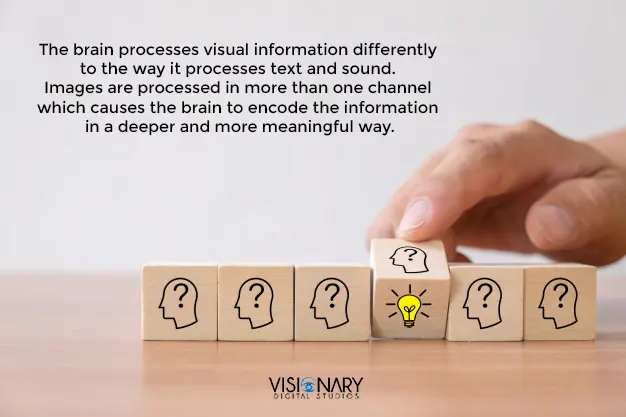PowerPoint is still the tool of choice for the vast majority of business presentations.
In spite of this popularity, it still has a bad reputation, many Directors find themselves scrambling to hold people’s attention during a presentation.
If you try to deliver too much information too quickly, you’ll notice your audience’s eyes still glaze over ….
So are slides the wrong tool? Not necessarily …
Here is more:
A Video Will Revolutionise Your Presentations
A recent study by Forrester showed that 1 minute of video conveys the same message value as 1.8 MILLION words!
If you spend the first few minutes of a presentation showing a premium Visionary Explainer Video, with a strategically crafted message, you can continue your pitch to a warm audience that already understands the value of your service.
We recommend clients to email the video the day before the presentation and play it on the day.
Here’s a great example of a video that is played at the start of presentations:
Less is More
One of the most famous Ted Talks took place in 2008, when renown explorer Robert Ballard made a historic presentation about his discovery of the wreckage of the Titanic.
Ballard had found the famous wreck in 1985. Perhaps just as astonishing as his discovery was the way he made his PowerPoint presentation…
Ballard chose to use no words. He had 57 had prepared slides in all, without a single word. The legend argued that he did not need to add text to his PowerPoint to relay the mystery and wonder of the deep ocean and the details of what he had found two and a half miles under the surface of the Atlantic Ocean.
The explorer explained that he saw himself as a storyteller and not as a lecturer.
It is already well documented that a PowerPoint presentation with too much text does not do a good job of passing on the information because people are not that good at multitasking.
Our brains won’t remember much information.
You don’t necessarily need to remove all text – just remember, video and images communicate much more powerfully.
A Picture Paints a Thousand Words
The answer to this problem is found in the field of neuroscience. Scientists have conducted countless experiments using different methods which have all proved that the human brain remembers pictures better than words. The principle is called Picture Superiority.
Convey information using just words and your audience will remember little. Use pictures and your audience will easily remember more than half of the information you shared with them.
This is because the way the human brain processes visual information is different from the way it processes text and sound. Images are processed in more than one channel which causes the brain to encode the information in a deeper and more meaningful way.
This is referred to as multimodal learning by scientists.
Invest time in finding quality photos that illustrate your story well. If you can find one or two that add a touch of humor, even the better.
Simplicity
Going visual doesn’t mean going all the way to add numerous bells and whistles. Things like slide transitions can be just as distracting as too much text.
Whenever you have to switch between different versions of PowerPoint, audio clips, videos, and animations will probably not play seamlessly. Distracting slide transitions will make your presentation look amateur.
This means that you have to be very careful with any use of audiovisual content. Rehearse several times – using the same computer that you will use on the final day of the presentation – to ensure that everything goes according to plan.
There is nothing more distracting than a PowerPoint presentation that suddenly stops playing.
Billionaire
One of the most impactful TED Talks was given in 2010 by billionaire and philanthropist Bill Gates called “Innovating to Zero”. While most people will cram 40 words into a single slide, Gates was 15 slides into his presentation before he had used up 40 words. Gates used more pictures and fewer words than the average presenter.
The Microsoft founder has a remarkable talent for reducing complex concepts and ideas into very simple terms.
It is not necessary to eliminate words completely like Ballard or Gates. Instead, just make a conscious effort to use more images than words. One challenge that always helps to deliver a more memorable presentation is to use a maximum of 40 words in the first 10 slides.
The idea is to tell a good story without much distraction.
Connect
So don’t start by typing text into a PowerPoint document.
Instead, begin by identifying the messages you want to convey. Then create an outline.
When you know what your message is – and you can condense it into one sentence – then you are in a position to communicate it effectively. People are will not make a purchase when they are bombarded with too much information.
Removing wordy slides will set you free to enjoy your presentation and connect better with your audience. Your eye contact and body language will improve. And they will thank you for it.
Wrapping It Up …
At the end of the day, your audience is not going to buy the powerpoint slides.
They are going to buy you. You are the one telling the story. You are the one they want to connect with. Don’t take that away from them.
Super-charge your presentation with a powerful Visionary Explainer Video, then persuade using imagery, story, and your unique X-Factor.



